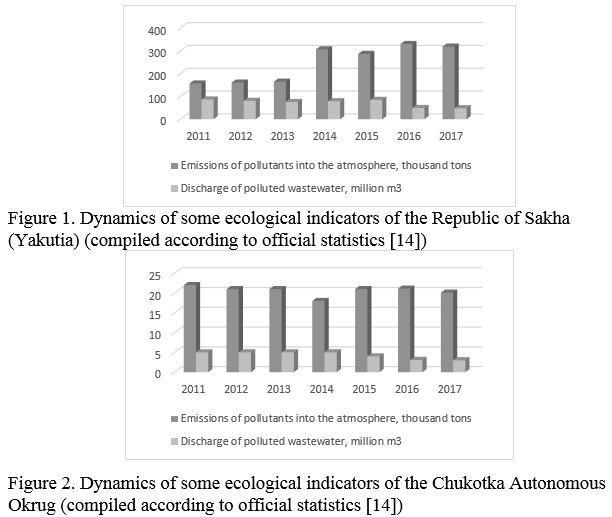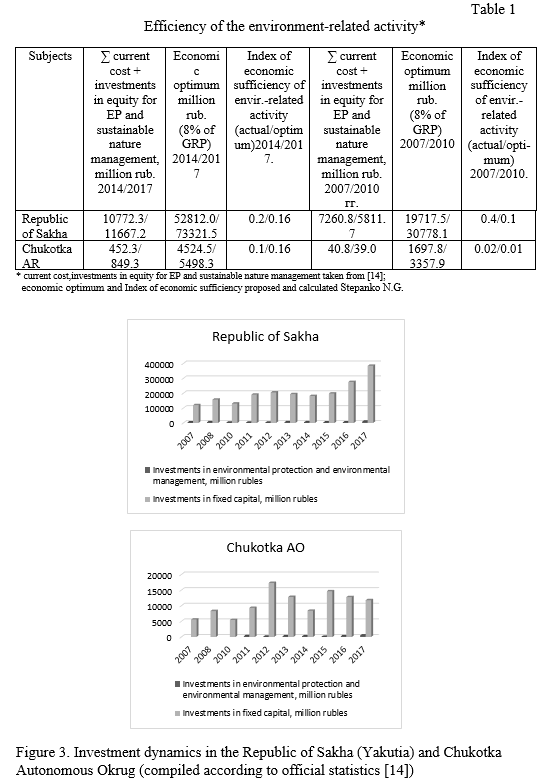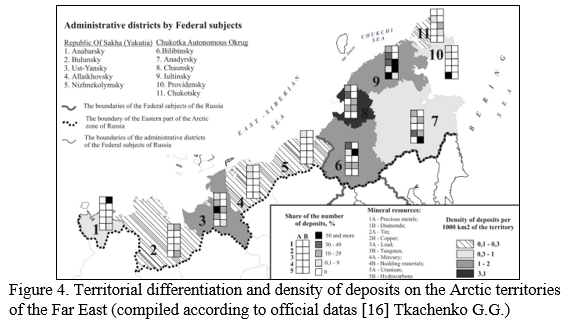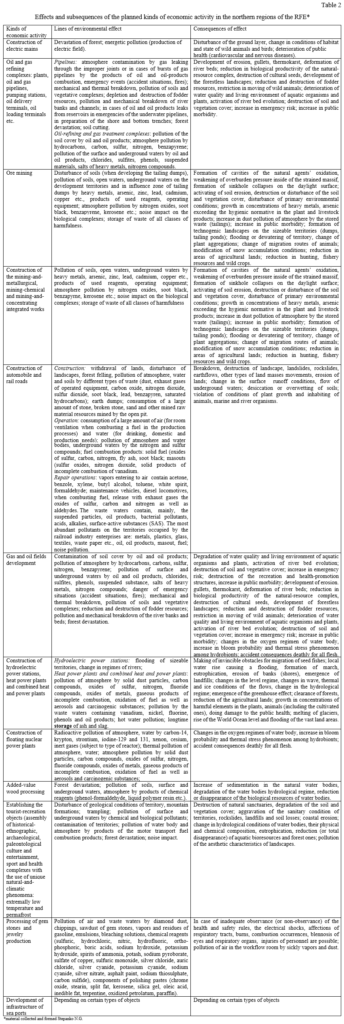
UDC 502.3:91 (571.65/66)
DOI 10.24411/2413-046Х-2019-10199
ECOLOGICAL AND ECONOMIC PROSPECTS OF THE NORTHERN TERRITORIES OF THE RUSSIAN FAR EAST
ЭКОЛОГО-ЭКОНОМИЧЕСКИЕ ПЕРСПЕКТИВЫ СЕВЕРНЫХ ТЕРРИТОРИЙ ДАЛЬНЕГО ВОСТОКА РОССИИ
The research was carried out within the state assignment of Ministry of Science and Higher Education of the Russian Federation/(Russia) (theme “Geographical and geopolitical factors in the inertia, dynamics and development of different ranked territorial structures of the economy and the settlement of the population of Pacific Russia ”, No. АААА-А16-116110810013-5), supported in part by RFBR (projects No. 18-05-60103,18-05-80006)
Степанько Наталия Григорьевна, к.г.н., старший научный сотрудник, Федеральное государственное бюджетное учреждение науки Тихоокеанский Институт Географии Дальневосточного отделения Российской Академии Наук
Степанько Алексей Александрович, к.г.н., ученый секретарь, Федеральное государственное бюджетное учреждение науки Тихоокеанский Институт Географии Дальневосточного отделения Российской Академии Наук
Ткаченко Григорий Геннадьевич, к.г.н., старший научный сотрудник, Федеральное государственное бюджетное учреждение науки Тихоокеанский Институт Географии Дальневосточного отделения Российской Академии Наук
Stepanko N. G., Stepanko A. A., Tkachenko G. G.
Summary: In connection with the ecological and economic contradictions of the further development of the Far Eastern North, the problem of choosing the most reasonable, balanced scenario for the development of these territories.The purpose of this study is to analyze the environmental and economic situation in these territories and identify possible changes in natural-industrial relations. The subject of the study is the correlation of economic opportunities for the further development and development of the Arctic territories of the Russian Far East (RFE) and the possible environmental consequences of this development. Using the method of statistical analysis, graphical and cartographic methods, the results are obtained: the causes of environmental problems were identified, based on the calculations, a characteristic of the ecological state and economic support of environmental protection is given, the possible environmental consequences when implementing the main, promising types economic activity. The presented study was performed for the considered territories for the first time.
Аннотация: В связи с эколого-экономическими противоречиями дальнейшего развития дальневосточного Севера встает проблема выбора наиболее обоснованного, сбалансированного сценария развития этих территорий.Целью данного исследования является анализ эколого-экономической ситуации на данных территориях и выявление возможных изменений в природно-производственных отношениях. Предметом исследования является соотношение экономических возможностей дальнейшего освоения и освоения арктических территорий Дальнего Востока России (РФЭ) и возможных экологических последствий этого освоения. С использованием метода статистического анализа, графического и картографического методов получены результаты: выявлены причины возникновения экологических проблем, на основе расчетов дана характеристика экологического состояния и экономического обеспечения охраны окружающей среды, возможные экологические последствия при осуществлении основных, перспективных видов хозяйственной деятельности. Представленное исследование было выполнено для рассматриваемых территорий впервые.
Key words: Far East Arctic zone, ecological situation, economic activity, mineral raw material base, economic sufficiency index.
Ключевые слова: Дальневосточная Арктическая зона, экологическая ситуация, хозяйственная деятельность, минерально-сырьевая база, индекс экономической достаточности.
Introduction. Territories of the arctic zone differ by the high vulnerability of the natural environment to the anthropogenic impacts and low rate of the restoring the damage of both separate components and natural environment as a whole [1]. An analysis of information on environmental condition of the Chukotka AR and Republic of Sakha (Yakutia) allows us to make a conclusion of the unfavorable environmental situation in the regions. At present time, the arctic zone of RF is under the heavy anthropogenic impact in the areas of developing the reserves of the most important mineral resources, first of all, natural gas and oil [2-6]. The surface waters in the areas of extraction of raw minerals and hydrocarbons, activity of the enterprises of ferrous and non-ferrous metallurgy, mining, pulp and paper industries, heat power industry, housing and utilities sector, transport etc. are subjected to very strong anthropogenic impact. The existing environmental management system in the particular areas of the Russian Arctic has resulted in the emergence of the strongly changed by the economic activity territories where the disturbance of the existing dynamic equilibrium of the environment has caused a change in the natural geochemical background, depletion of biodiversity, degradation of soils and vegetation, development of erosion processes and environmental pollution [7-9]. Based on results of the Russian Federation regions ranking in respect of the quality of life [10], where the indicators of environmental quality were included along with the socio-economic indices, the Republic of Sakha (Yakutia) and Chukotka AR have occupied 72/65 and 79/80 places in 2015/2014 among considered 85 regions. In this regard, in addition to the economic interest in the development and development of the Far Eastern Arctic of Russia, the problem of balancing environmental and economic interests and preserving these unique territories is becoming urgent for the world community.
The main objectives of our study are:
- give detailed characteristics of the natural, environmental and economic situations in the studied territories;
- evaluate the effectiveness of environmental protection and environmental management activities existing in these territories;
- identify the main existing environmental problems and determine the possible influences and consequences of the implementation of the planned types of economic activity.
Materials and methods. The work was carried out on the territory of the uluses of a certain and approved at the time of the study of the Arctic zone of Sakha (Yakutia): Allaikhovsky, Anabarsky, Bulunsky, Ust-Yansky and Nizhnekolymsky and all municipal areas of the Chukotka Autonomous Region (Anadyrsky, Bilibinsky, Chukotsky, Iultinsky (now UD Egvekinot) districts, urban districts Providensky and Pevek). The official statistics were used (Federal State Statistics Service, Russian Geological Fund): current costs and investments in fixed assets for environmental protection and environmental management, investments in fixed assets, emissions of polluting substances into the atmosphere, discharge of polluted wastewater, structure of emissions of polluting substances, resource structure of the mineral resource base, as well as calculated by the author economic optimum of environmental costs, the proposed and calculated index of economic sufficiency of environmental activities, compiled diagrams and a map of differentiation and density of mineral deposits. The time period is 2007-2017. for the analysis of the dynamics of the process, for comparative analysis – individual years. This choice was determined by recessions and ups in the economy, as well as the availability of comparable information.
Research results. The major constituents of the environmental condition on the territories under consideration include pollution of air and water, production of industrial and household waste and contamination by them of territories as well as radiation pollution. According to data of the Federal Service for Hydrometeorology and Environmental Monitoring, the radiation background on these territories is within normal limits and atmospheric air pollution has also significantly decreased [11].
Last years the river waters were rated as “polluted” and “much polluted”. The priority pollutants were the organic substances, compounds of iron, copper, zinc and manganese, phenols and oil products. And, despite the fact that the volumes of discharged polluted wastewaters did not practically increase (Figs.1-2), according to the State report on the environmental situation in the Republic of Sakha (Yakutia) [12], the state of surface waters degrades. This is explained by the fact that the majority of working wastewater treatment facilities was constructed more than 30-40 years ago. The technical condition of many of them is unsatisfactory, treatment technology is obsolete and, often, the facilities of only mechanical treatment function and, therefore, the operated facilities do not provide the standard sewage water treatment. The undertaken earlier investigations showed that only 2 districts in the Chukotka Autonomous Region – Anadyrsky and Iultinsky – were subjected to partial limitation of the water-intensive enterprises functioning in connection with pollution of water resources in the Arctic territories of the Russian Far East. The rest of districts of Chukotka (Bilibinsky, Chukotsky, UD Providensky, UD Pevek) have no limitations [13].

The other significant problems for the Arctic territories of the Far East are production and storage of solid industrial and household waste as well as formation of unsanctioned landfills, which results in pollution of territories, underground and surface waters, disturbance of landscapes etc.
The greatest volume of wastes is produced at the enterprises of mining industry and basic mass of them is comprised of the overburden rocks, concentration tailings and ash and slag dumps. High volume and rate of waste accumulation and poor development of the waste recycling industry lead to the fact that the main method of disposal is the waste burial in the dump sites. The sanitary condition of the disposal sites remains unsatisfactory: enclosure and banking are often absent, the territories and approach roads are not well-equipped and overcrowded with waste, the works in recultivation are not carried out, the asset holder of the dump is not determined, the register of waste generators is not kept and accounting of household waste income is not arranged at the level of municipal entities, settlements etc. [12]. The changes in the land categories occur also. The changes in areas took place in four categories: in lands of agricultural designation, in industrial, transport and other lands, in forest reserve lands and in reserve lands, provided that the increase in areas occurred only in the industrial land category while the areas of agriculture and forest reserve lands decreased.
On the territories of the Far-Eastern northern regions, the options of expanding the areas used in the agriculture are severely limited. Development of new lands for agricultural exploitation can be exercised here only after taking the cost-intensive melioration measures. By now, in a majority of the Far-Eastern regions, the all-round reduction in both areas under crops and agricultural lands as a whole took place as a result of crisis situations. The extensive types of land use occupy territories to north of the agricultural areal where the reindeer breeding is developed. In the majority of cases, the reindeer breeding is a part of traditional use of natural resources by the indigenous minorities. The reindeer-breeding type of land use is presented by the reindeer breeding proper and reindeer breeding with the patchy agriculture. The agriculture is presented on these territories by small areas of agricultural lands in the vicinity of settlements which are used by the local population for production of the vegetable and dairy products.
Apart from the economic activity, the efficiency of nature management is also formed by the environment-related activity. The efficiency of the environment-related activity in these regions is very low (Table 1) and, according to our calculations and official statistics [12,14], these tendencies retain also in current times.
In view of the financial maintenance of the activity aimed at the reduction in negative impact of the production on the environment, the current cost, investments for the environment protection (EP) and sustainable nature management as well their structure do not meet the necessary ones [15] (Table 1, Fig.3). The actual volumes of investment in the EP are enormously small as compared to the economic optimum, which proposed by S.I. Kolesnikov and must comply with 8% of GRP (Gross Regional Product) [15]. This is evidenced by the index of economic sufficiency (IES) of the environment-related activity, which is defined by the ratio of the actual volumes of financing the EP and sustainable nature management and economic optimum at the optimal value of IES-1.

The territories of the northern regions having in possession the various and significant by reserves natural resources are by far ones of the prospective development. The structure of the Far-Eastern mineral resource base as a whole is characterized by a predominance of the deposits of the solid commercial minerals. In its arctic zone, 1115 deposits and sectors of the solid mineral raw materials and hydrocarbons were revealed and some of deposits are developed [16]. 77% of deposits located in the East of the Russian arctic zone fall on the Chukotka Autonomous Region. Their maximum number was registered in the Bilibinsky, Iultinsky and Chaunsky districts of Chukotka as well as in Ust-Jansky district of Yakutia [17].
The leaders by the variety of deposit types are the Iultinsky district of the Chukotka AR and Ust-Jansky district of Yakutia because, in each of them, 8 of 11 basic mineral-resource groups are presented. More than half of the tungsten, uranium and common commercial minerals deposits and one third of the tin and lead ones in the Far-Eastern arctic zone fall on the Iultinsky district of Chukotka AR. In the Ust-Jansky district of Yakutia, two thirds of lead deposits and fourth of mercury deposits are concentrated. One can also identify such districts of Chukotka as Anadyrsky (more than 70% of hydrocarbons deposits), Bilibinsky (80% of copper deposits and 42% of noble metal ones), Chaunsky (40% of tin deposits). In the group of districts with poor variety of deposits, one can note the Providensky district where, nevertheless, a half of uranium deposits was discovered and Anabarsky district of Yakutia on which three fourths of diamond deposits of the Far-Eastern arctic zone fall (Fig.4) [17].
Therefore, one can identify the crucial significance of the extractive sectors in the industrial structure of the Far-Eastern arctic zone. To them, the prospects for the development of these regions are related which is confirmed by the basic tendency (extraction and processing) of the investment projects under consideration: Anabarsky ulus (oil, gas), Bulunsky ulus (oil, gas), Allankhovsky ulus (construction raw materials, in particular, broken stone), Ust-Jansky ulus (tin, gold) in Sakha (Yakutia) and Anadyrsky ulus (Beringovsky settlement) (underground and quarry mining, enrichment and transshipment of sintering coal; copper, gold, silver) in the Chukotka AR [18,19]. And only three projects are characterized by the environment-oriented trend: “Ecologically-safe conservation of the tailing dump of the Deputatsky ore mining and processing enterprise” (Ust-Jansky ulus, Yakutia), “Construction of the mini-plant for recycling of the municipal solid waste in the settlement of Chokurdakh” (Allankhovsky ulus, Yakutia) and “Production of clean water in the settlement of Chokurdakh” (Allankhovsky ulus, Yakutia) [based on materials “Strategy …” [19].

In Table 2, an analysis of possible subsequences of the prospective kinds of production activities at existing parameters (current level): environmental situation, technologies of production and waste disposal, economic resilience of the environment-related activity, absence of the investment projects with environment-related orientation, lack of the necessary infrastructure facilities as well as occurrence of the negative natural phenomena and potential emergency situations is presented. It is evident that the risks of significant damage to population life activity will be sufficiently high.
Discussion. In accordance with the purpose of this work and the objectives he performed research has shown that:
1. considered territories have great possibilities for the further development and are attractive to investors;
2. in current times, the arctic territories of the RFE have suffered changes as a result of the negative man-caused impact the basic consequences of which are air and water pollution, generation of industrial and household wastes and pollution of the territories by them;
3. in this connection and also as a result of the low resistance and regenerative capability, they are exposed to significant risks posed by a realization of the assumed kinds of economic activity up to irreversible subsequences and causing the material damage to the life-sustaining activity of people;
4. for realization of prospects for development of these territories, the measures to elimination of the existing adverse pollutions and disturbances as well as the landscape restoration should be high-priority. Over recent years, it has become fashionable to speak [20-25 and etc.] of the green economy considering it as something new: green economic growth, new concept of the economic growth, wider than currently accepted. In particular, it is suggested to take into account the damage accompanied of the economic growth and afflicted to the environment and other similar losses of the national wealth. As the growth continues to destruct the natural capital, the risks for development are raised. If this tendency is not restrained then it can result in aggravation of deficiency of water and other resources, higher pollution, climatic changes and irreparable loss of biodiversity.

All of this enters into the concepts of “rational nature management”, “sustainable nature management” etc. Only one more term “green economy”, “green economic growth” was added [26,27]. The situation remains constant because the ecological component holds so far third position in order of importance next economic and social ones. And as long as this disbalance in the priorities will exists, the environmental conditions will deteriorate which will have a significant impact on biodiversity, purity of environment and above all on a human, its health and life activities. As an initial stage, it is necessary to put together a special program on realization of the “green” economy principles including also individual branches of the national economy in the regions.
In that respect, in our opinion, a realization of the following measures is of great importance:
1.When developing the investment projects (including with involvement of the foreign companies) as well as programs of prospective development, the high-priority measures should include establishing the structures intended for nature protection purposes. In the short term, the development of the territories in question, in our opinion, should not be based on extractive industries, but on economically sound and environmentally sound types of economic activity:
2. Development of alternative energy:
- biofuel (made of the agricultural waste and wood raw materials);
- helioenergetis;
- wind power plants;
3. Development of environment-oriented and simultaneously economically sound technologies:
- introduction of the modern building methods with the use of new kinds of construction materials;
- manufacture of ecologically pure products;
4. Development of traditional types of activity and breeding of traditional species of plants and animals (especially, for traditional indigenous habitats):
- traditional kinds of agriculture;
- traditional types of the northern people activity;
- eco-tourism;
5. Activation of the forest-protection and reafforestation works;
6. Reduction of emissions and discharges;
7. Waste utilization as the secondary raw material;
8. Land reclamation (depletion, disturbance, pollution);
9. Organic agriculture;
10. Cost-effective use of resources;
When preparing the programs of developing the arctic territories of the Russian Far East, the results of the research conducted and conclusions can be used by the appropriate administrative arrangements of different hierarchical levels and also organizations of the environmental orientation. In addition to it, we plan to give consideration to the existing structure of nature management and determine the possible structure, tendencies and consequences of the production-nature relations in accordance with the planned investment projects of developing these territories.
Conclusions. In the Strategy of the sustainable development of the arctic uluses [18,19], it is emphasized that “The long-time benchmark of developing the arctic uluses and areas of compact settlement of the indigenous minority of the North is a provision of the transition to the effective model of development, namely, balanced solving the problems of developing the industry and traditional kinds of economic management of the North nationalities under the conditions of obligatory preservation of the natural ecological systems and biological diversity”. Concerning the balanced state in general and for the territories under consideration in particular, it will be difficult to combine the development of industry (mainly, extractive and greatly affecting ones) with the preservation of the natural ecological systems and biological diversity“. We consider that the ecological balance of the nature management should have a primacy. Certainly, the development of traditional kinds of economic management the indigenous minority of the North is one of the main components of this model. Apart from that, the realization of the environmental projects and use of innovative technologies are necessary. The successful sustainable development of the arctic territories is possible only with the government assistance and economic regulation including the organization of hunting, fishery, deer farming and other national businesses as well as activation of the real, essential to the arctic territories activity in the field of environmental protection and efficient use of natural resources. A successful development of the Far-Eastern North territories on the principles of the “green economy” depends upon the active position of the federal and regional governments, granting tax exemptions and other preferences for the “green” business and, most importantly, on strict control of its accomplishment and adoption of effective sanctions as provided for in the legislation.
References
1.Hein, K. (2016). Spatial scales, stakeholders and the valuation of ecosystem services / K. Hein, R.S. Koppen, E.C. de Groot. Ecological economics, 57, 209-228.
2. Barros, V.R. (2014). Climate change 2014: impacts, adaptation, and vulnerability. Part B: regional aspects. Contribution of Working Group II to the fifth assessment report of the Intergovernmental Panel on Climate Change. Cambridge University Press. [Electronic source] URL://www.ipcc-wg2.org/AR5/images/uploads/WGIIAR5-FrontMatterB_FINAL.pdf (reference date 17.04.2019).
3. Chapin, F.S. III. Sommerkorn, Martin; Robards, Martin D. (2015). Ecosystem stewardship: A resilience framework for arctic conservation. Global environmental change-human and policy dimensions, 34, 207-217.
4. De Groot, R. (2012). Hussain Global estimates of the value of ecosystems and their services in monetary units. Ecosystem Services, 1, 1, 50-61.
5. Moe, A. (2016). The dynamics of Arctic development. Asia in the Arctic. Singapore: Springer, 3-13.
6. Rempel, H. (2011). The Arctic’s Raw Materials Potential and Deposits. Osteuropa, 61, 2, 113.
7. Broderstad, E.G. (2014). Resilient communities? Collapse and recovery of a social-ecological system in Arctic Norway. Ecology and society, 19, 3. [Electronic source] URL://www.dx.doi.org/10.5751/ES-06533-190301 (reference date 17.04.2019).
8. Davies, W. (2015). ‘Frame Conflicts’ in Natural Resource Use: Exploring Framings Around Arctic Offshore Petroleum Using Q-Methodology. Environmental Policy and Governance, 26, 6, 482-497. [Electronic source] URL://www.doi.org/10.1002/eet.1668 (reference date 17.04.2019).
9. Kapyla, J. (2016).The promise of the geoeconomic Arctic: a critical analysis. Asia Europe Journal, 14, 2, 203-220.
10. Ranking of RF regions by quality of life – 2015. (2016). RSA Ranking. Moscow, 61. [Electronic source] URL://www.vid1.rian.ru/ig/ratings/life_2015.pdf (reference date 17.04.2019).
11. Review of the environmental state and pollution in the Russian Federation over 2015. (2016). Federal Service for Hydrometeorology and Environmental Monitoring (Rosgidromet). Moscow, 203. [Electronic source] URL://www.meteorf.ru (reference date 17.04.2019).
12. Brief state report on the environmental situation in the Republic of Sakha (Yakutia) in 2018.Government of the Republic of Sakha (Yakutia), Ministry of Nature Protection of the Republic of Sakha (Yakutia), prepared The Ministry of Ecology, Nature Management and Forestry of the Republic of Sakha (Yakutia), authorized executive body of state power of the Republic of Sakha Yakutia) in the field of environmental protection. 2019.Yakutsk, 61p. [Electronic source] URL:// www.minpriroda.sakha.gov.ru/gosdoklady-o-sostojanii-okruzhajuschej-sredy (reference date 17.04.2019).
13. Stepanko, N.G. (2017). Nature-production relations in the Far-Eastern North regions. Advances of the modern natural sciences, 4, 120-125.
14. Regions of Russia. (2018). Socio-economic indicators. 2018: R.32: Statistical book. Federal State Statistics Service. Moscow, 1162.
15. Kolesnikov, S.I. (2000). Economics of nature use. Study guide. Rostov-on-Don, 14-15.
16. Accounting items of the national cadastre of mine fields. Federal Agency on Mineral Resources. Rosgeolfond. (2019). [Electronic source] URL://www.rfgf.ru/gkm(reference date 17.04.2019).
17. Tkachenko, G.G. (2016). Territorial differentiation of the mineral-resource fields in the East of the Arctic zone of Russia. Geosystems and their components in the Northeast Asia: evolution and dynamics of natural, natural-resource and socio-economic relations. Vladivostok: Dalnauka, 557-564.
18. Strategy of the social and economic development of the Chukotka Autonomous Region until 2030. Official site of the CAR administration. (2016). Anadyr, 36. [Electronic source] URL://www.чукотка.рф/power/priority_areas/priorities_for_development/development-strategy.php(reference date 17.04.2019).
19. Strategy of socio-economic development of the arctic zone of the Republic of Sakha (Yakutia) for the period until 2030. Center for strategic studies of the republic of Sakha (Yakutia). (2018). Yakutsk, 141.
20. Araya, D., Shang, J., Liu, J. (2011). ICTs and the green economy: U.S. and Chinese Policy in the 21st Century . Chapter 11. T. Houghton, (Ed.), (pp. 239-254). New York: Peter Lang.
21. Barbier, E. (2011). The policy challenges for green economy and sustainable economic development. Natural Resources Forum, 35, 233-245.
22. Greening The Economy With Climate-Smart Agriculture. (2012). Background
Paper for the Second Global Conference on Agriculture, Food Security and Climate
Change Hanoi, Vietnam, 3-7 September, 52.
23. Inclusive Green Growth: The Pathway to Sustainable Development. (2012). Washington, DC: World Bank. [Electronic source] URL://www. siteresources.worldbank.org/ (reference date 17.04.2019).
24. Johnson, M. (2010). Green Economy as a System. Harvard Business Review, 1/2, 87-95.
25. Webber, M., Smith, M. (2014). Foreign Policy in a Transformed World. Routledge, 392.
26. Dudin, M.N. (2017). Sixth technological mode and green economy as the basis of strategic reclamation of Arctic territories . Academy of Strategic Management Journal, 16, S1, 71-81.
27. Kelmelis, J. (2011). A.Arctic Warming Ripples through Eurasia. Eurasian geography and economics, 52, 1, 56-78.


